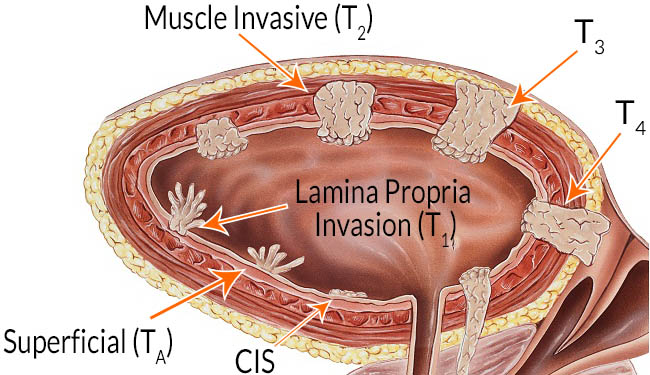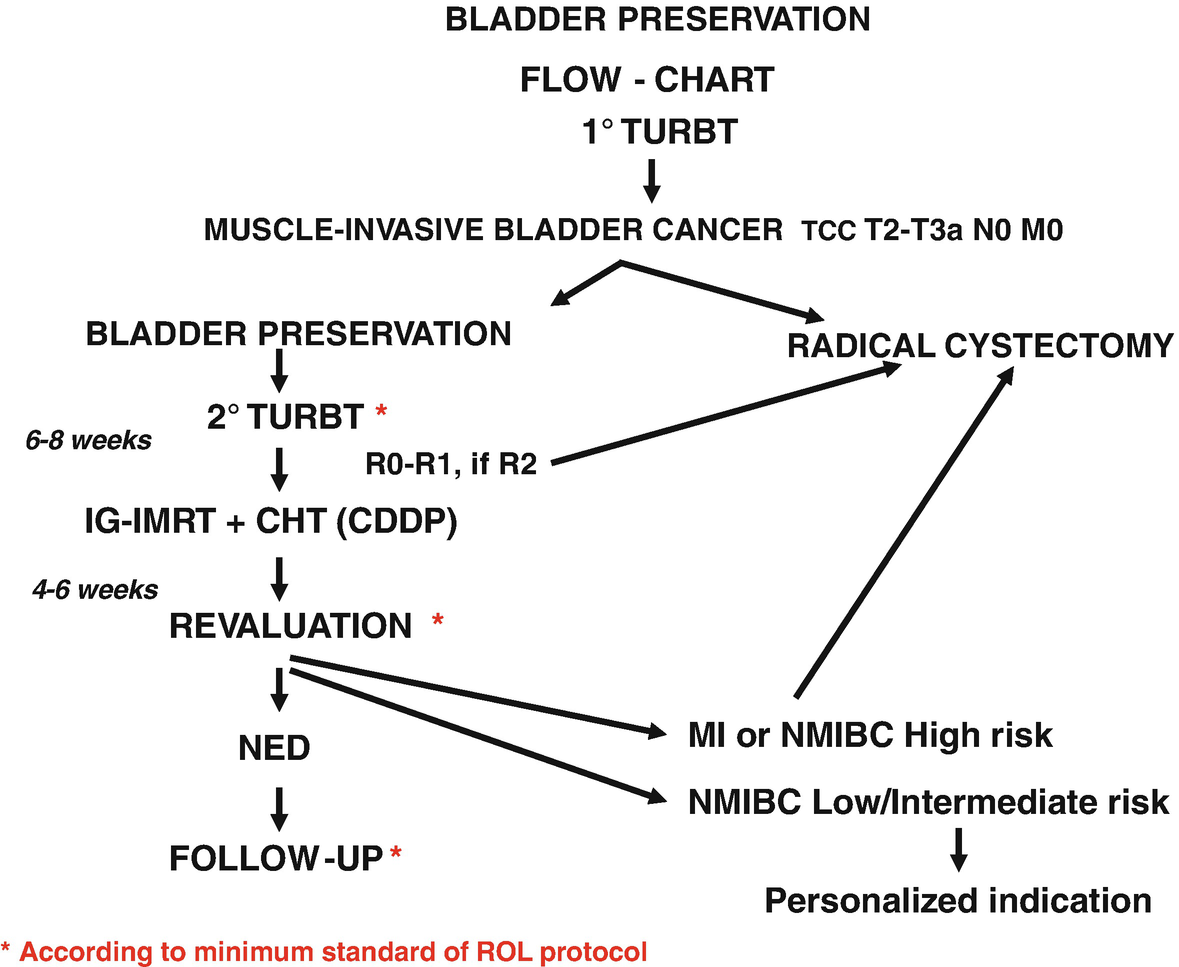Papillary tumor without invading the bladder wall TIS CIS. Bladder Cancer is one of the most deadly types of cancer and it commonly begins with a malignant tumor that has spread through the entire urinary tract.
 Bladder Cancer Overview Symptoms Diagnosis Treatment
Bladder Cancer Overview Symptoms Diagnosis Treatment
Tumor invades the muscle layer T3.

Types of bladder cancer tumors. Squamous cell carcinoma of the bladder is a type of bladder cancer that is very rare in the United States. Transurethral bladder tumor resection TURBT. Surgical options to treat bladder cancer include.
Squamous cell carcinomas in the bladder tend to be the invasive type of cancer. This is also called urothelial bladder cancer. There are other less common types of bladder cancer including sarcoma of the bladder and small cell bladder cancer.
Tumor penetrates the bladder wall and invades the surrounding fat layer. What things to learn about BCG therapy Bacillus CalmettevЂGuerin is a kind of immunotherapy that health practitioners may use to deal with some types of bladder cancer tumors. Each type of bladder cancer depends on how tumor cells look under a microscope.
The following are the stages for bladder tumors. Cancer cells of this type look like the urothelial cells lining the inside of the. Tumor invades the connective tissue under the surface lining T2.
Stage 0 bladder cancer includes non-invasive papillary carcinoma Ta and flat non-invasive carcinoma Tis or carcinoma in situ. Small cell bladder cancer is a rare type of bladder cancer that is likely to spread to other parts of the body. In either case the cancer is only in the inner lining layer of the bladder.
It accounts for about 5 percent of bladder cancers in North America and Europe. 1-3 The cancer cells look different under a microscope than the type of cancer cells involved in urothelial bladder cancer. Sarcomas of the bladder often begin in the fat or muscle layers of the bladder.
Transurethral resection of bladder tumor TURBT. Urothelial carcinoma is the most common type of bladder cancer in the United States. The most common type is transitional cell carcinoma.
Urothelial Carcinoma also called transitional cell carcinoma is the most common type of bladder cancer accounting for more than 90 of all bladder cancers. These cancers start in the urothelial cells that line the inside of the bladder. It begins in the transitional cells in the inner layer of the bladder.
Doctors often use the chemo drug cisplatin to treat the most common type of bladder cancer called urothelial carcinoma. Other ways of describing bladder cancer. In this specific article we will talk about just just just what Bacillus three day.
Rarer types include squamous cell bladder cancer adenocarcinoma sarcoma and small cell bladder cancer. Squamous Cell Carcinoma of the Bladder Squamous cell carcinoma is the second most common type of bladder cancer. The most common type of bladder cancer is transitional cell bladder cancer.
Doctors also describe your bladder cancer based on how far it has spread into the bladder wall. It has not invaded spread deeper into the bladder wall. Well cover the various types of benign bladder tumors as well as how they.
Other types include squamous cell carcinoma and adenocarcinoma. Diagnosis is typically by cystoscopy with tissue biopsies. After surgery to eliminate the cancer tumors this therapy will help stop the cancer tumors from going back.
Physicians could also make use of BCG as a form of intravesical immunotherapy to treat some very very very early types of bladder cancer tumors. Though the vast majority of bladder cancers are urothelial other types of the disease do occur. Benign bladder tumors are relatively common noncancerous growths that may cause discomfort or issues with urination.
Carcinoma in situ non-invasive flat high-grade G3 cancer T1. This type accounts for about 95 percent of bladder cancers. In fact if you have bladder cancer its almost certain to be a urothelial carcinoma.
Cisplatin works by. Urothelial carcinoma transitional cell carcinoma Urothelial carcinoma also known as transitional cell carcinoma TCC is by far the most common type of bladder cancer. Bladder cancer is categorized by a number of types depending on where exactly it forms along with other factors.
During TURBT a surgeon inserts a cystoscope through the urethra into the bladder. Risk factors for bladder cancer include smoking family history prior radiation therapy frequent bladder infections and exposure to certain chemicals. Transitional cell carcinoma Transitional cell carcinoma is the most common type of bladder cancer.
Immunotherapy functions by encouraging a personvЂs system that is immune strike and destroy cancer tumors cells. The most common type of bladder cancer is transitional cell urothelial carcinoma TCC. Intravesical ensures that the procedure particularly targets the bladder.
This procedure is used for diagnosis and staging as well as treatment.
This type of bladder cancer often comes back after treatment usually as another noninvasive cancer in the bladder. The medication remains in your bladder for a period of time and then is drained.
 Radiotherapy For The Treatment Of Muscle Invasive Bladder Cancer Springerlink
Radiotherapy For The Treatment Of Muscle Invasive Bladder Cancer Springerlink
There are essentially two ways to treat patients with Stage II T2 bladder cancer.

T2 bladder cancer treatment. Chemotherapy uses drugs to kill cancer cells. The present study analyzed the survival rate in patients with stage T2-T3a bladder cancer who had been treated by radical cystectomy. The tumor has spread to the connective tissue called the lamina propria that separates the lining of the bladder from the muscles beneath but it does not involve the bladder wall muscle.
The type of a cancer tells you what type of cell it started in. For MIBC chemotherapy will most likely be given before radical total cystectomy. Since there are relatively few treatment options for metastatic bladder cancer clinical trials are often the best treatment option for most patients.
Between 2003 and 2007 45 patients were enrolled. Currently the standard first-line treatment options include chemotherapy regimens that contain cisplatin- or carboplatin-based chemotherapy. Transurethral resection TURBT is typically the first treatment for these cancers but its done to help determine the extent stage of the cancer rather than to try to cure it.
Bladder cancer that comes back after treatment a recurrence has a poorer prognosis than bladder cancer that happens for the first time a primary tumour. The stage tells you the size of the cancer and whether it has spread. The optimal treatment for patients with localized muscle-infiltrating urothelial carcinoma Jewett stage B or T2-T3a of the TNM classification UICC 1992 continues to be a controversy.
The more recurrences the poorer the prognosis. Your urologist oncologist and clinical nurse specialist will discuss your treatment options with you which will either be. Radical cystectomy is a standard treatment for invasive bladder cancer.
People with smaller bladder tumours have a better prognosis than people with large tumours. Treatment for stage 2 bladder cancer may involve removal of part or all of your bladder. Some people with superficial bladder cancer experience frequent recurrences throughout their.
Bladder cancer has a tendency to recur so when treatment ends youre still considered at high risk. A radical cystectomy involves removal of the bladder tissue around the bladder the prostate and seminal vesicles in men and the uterus fallopian tubes ovaries anterior vaginal wall and urethra in women. After TUR-BT patients received radiotherapy RT of the bladder and regional lymph nodes.
Bladder removal cystectomy with chemotherapy or without chemotherapy. An operation to remove your bladder cystectomy radiotherapy with a radiosensitiser. The staging system most often used for bladder cancer is the American Joint Committee on Cancer AJCC TNM system which is based on 3 key pieces of information.
Treatments for muscle invasive bladder cancer include. A controlled trial of preoperative chemotherapy conducted by the Medical Research Council and the European Organization for Research and Treatment of Cancer randomly assigned 976 patients with locally advanced T3 or T4a or high-grade muscle-invasive T2 bladder cancer to undergo either definitive treatment immediately or definitive treatment. With T2 and T3 bladder cancer treatment aims to cure the condition if possible or at least control it for a long time.
So youll need other treatments along with or instead of an operation. Many people with bladder cancer need surgery. But in some cases it cant remove all of the disease.
The number of treatment options for patients with muscle-invasive bladder cancer is expanding. If treatment is delayed or unsuccessful. Chronic or repeated urinary infections or inflammations cystitis such as might happen with long-term use of a urinary catheter may increase the risk of a squamous cell bladder cancer.
All this information helps your doctor decide which treatment you need. Chemotherapy with radiation in addition to TURBT. People who received radiation treatments aimed at the pelvis for a previous cancer have a higher risk of developing bladder cancer.
Treating stage II bladder cancer These cancers have invaded the muscle layer of the bladder wall T2a and T2b but no farther. The grade tells you how much the cancer cells look like normal cells. To assess the safety and effectiveness of treating high-risk T1 and T2 bladder cancer with transurethral resection TUR-BT followed by radiochemotherapy RCT combined with regional deep hyperthermia RHT.
As part of the TURBT procedure your doctor may recommend a one-time injection of cancer-killing medication chemotherapy into your bladder to destroy any remaining cancer cells and to prevent cancer from coming back. T describes how far the main primary tumor has grown through the bladder wall and whether it has grown into nearby tissues. Radical cystectomy is currently the standard approach to disease management with recent a series.
Primary surgical treatment consisting of radical cystectomy with some form of urinary diversion or combined modality treatment consisting of administration of chemotherapy andor radiation therapy followed by radical cystectomy only for those patients who do not achieve a complete response. This can affect the way you urinate for the rest of your life.